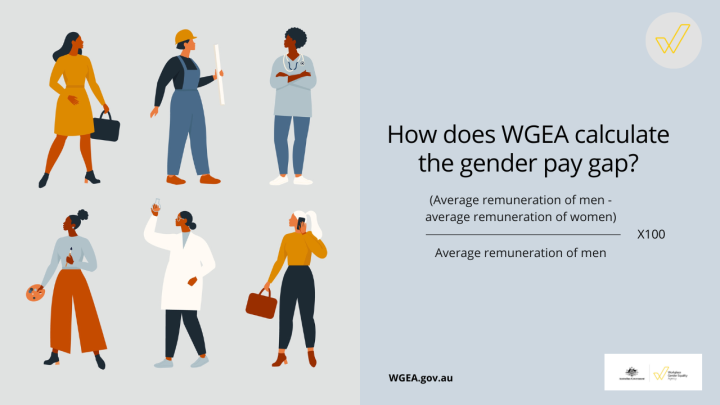The gender pay gap explained simply is a measure of how we value the contribution of men and women in the workforce.
Expressed as a percentage or a dollar figure it shows the difference between the earnings of women and men.
Closing the gender pay gap is important for Australia's economic future and reflects our aspiration to be an equal and fair society for all.
The gender pay gap is not the same as equal pay
Equal pay is where employees are paid the same for performing the same work or different work of equal or comparable value.
In Australia, this has been a legal requirement since 1969.
Gender pay gaps are not a comparison of like roles. Instead, they show the difference between the average or median pay of women and men across organisations, industries and the workforce as a whole.
The gender pay gap explained
The gender pay gap can be hard to understand. And there's a lot of misinformation on social media.
To make it easier, we've broken down some of the most common myths that are still pervasive when we talk about why women earn less on average than men.
How is the gender pay gap calculated?
WGEA publishes both average and median gender pay gaps.
Measuring gender pay gaps by median allows us to understand the remuneration experience of the typical employee at a workplace, as it is not skewed by exceptionally high or low salaries. The average gender pay gap is a good measure of the collective remuneration of a group. As the average is skewed by exceptionally high or low salaries, it will show if earnings are particularly concentrated for one gender, for example, more men in higher earning positions.
In 2024, WGEA has only published median employer gender pay gaps due to the exclusion of CEO and Head of Business remuneration. From 2024 reporting, when this pay information is included, WGEA will also report average employer gender pay gaps.
An average gender pay gap is the difference between the average earnings for men and women, expressed as a percentage of men's average earnings.
A median gender pay gap is the difference between the median of what men are paid and the median of what women are paid, expressed as a percentage of the median man's earnings.
The two gender pay gap datasets
Australia reports two gender pay gaps at a national level. This is because Australia has two key data sets with different information on employee wages (remuneration). Using this data, the gender pay gap can also be broken down by state, industry and age.
Calculating the gender pay gap from both data sets allows us to see trends and differences that could be used to improve workplace gender equality in Australia.
The annual Workplace Gender Equality Employer Census
WGEA's annual gender pay gap data, released in November, comes from the annual Employer Census. Under the Workplace Gender Equality Act 2012, non-public sector employers with 100 or more employees to report to WGEA on a range of indicators, including employee remuneration.
The data set:
- includes the remuneration of employees working for employers with 100 or more staff
- uses total remuneration, including superannuation, overtime, bonuses and other additional payments
- Includes full-time, part-time and casual employees (converted into annualised full time equivalent earnings)
- excludes salaries of CEOs, heads of business, casual managers and employees who were furloughed.
Australian Bureau of Statistics' survey of Average Weekly Earnings
WGEA calculates the national gender pay gap using the Australian Bureau of Statistics (ABS) data released in February and August. This data comes from a sample of employers selected from the Australian Business Register, with a slightly different sample taken each time.
This data set:
- estimates full-time weekly base salary employees in public and private sector
- excludes overtime, pay that is salary sacrificed and superannuation
- excludes junior and part-time employees.
The difference in these two data sets means the national gender pay gap is often lower than WGEA's gender pay gap.
Click here to download WGEA's fact sheet 'What is the gender pay gap?'
What causes the gender pay gap?
The gap between women and men's average earnings is the result of social and economic factors that combine to reduce women’s earning capacity over their lifetime.
Watch the video below to understand some of the most gender pay gap common causes.
These factors include:
- conscious and unconscious discrimination and bias in hiring and pay decisions
- women and men working in different industries and different jobs, with female-dominated industries and jobs attracting lower wages
- lack of workplace flexibility to accommodate caring and other responsibilities, especially in senior roles
- high rates of part-time work for women
- women’s greater time out of the workforce for caring responsibilities impacting career progression and opportunities
- women’s disproportionate share of unpaid caring and domestic work
How can we reduce the gender pay gap?
Closing the gender pay gap requires cultural change to remove the barriers to the full and equal participation of women in the workforce.
Some of the ways that business can reduce the gender pay gap include:
- conducting an audit to understand the size of the gender pay gap
- reporting the findings to management and employees
- setting KPIs for leadership to reduce the gender pay gap
- taking action to increase the number of women in leadership positions
- encouraging men to access flexible work arrangements and leave entitlements.
To find out more ways to improve workplace gender equality in your business, click on the Take Action button bellow.
Find out how you can reduce the gender pay gap in your workplace
Explore the data on workplace gender equality in Australia
Learn more about WGEA and the work we do
